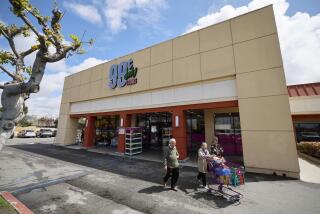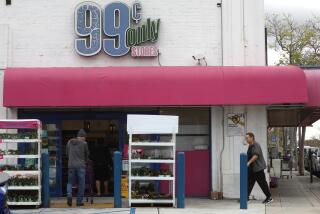Guitar Center looked ready for its swan song, but now the retailer is gearing up for an encore

- Share via
Marc Pritcher sat at the electric piano with his back to the patrons milling around the Guitar Center, unaware of the audience slowly gathering behind him.
Most mornings, the 66-year-old talent manager tries to make it into one of the retailer’s stores to play. In the last five months alone, he has written 30 songs, almost all while sitting at a set of keys in a Guitar Center.
On this day, Pritcher was working on “In Your Loving Arms,” an original country pop composition, when he started to hear the strains of background vocals.
Behind him, two customers were taking stabs at the chorus, which quickly led to an impromptu concert aided by 20 fellow customers.
“It would have gone viral. It was so cool,” remarked Pritcher, as he tapped the keys on the $1,700 Yamaha piano at a Sherman Oaks store. “Music is the greatest — it doesn’t matter color, age, language. It just gets through to everybody.”
Little did he know it, but that’s the spirit Guitar Center executives are counting on as they try to engineer a turnaround of the retailer.
The plan is to make the stores more welcoming to budding and veteran musicians alike who are ready to spend money on equipment, supplies and other goods and services.
The privately held company has been on a perilous financial path, with analysts recently raising concerns that the Westlake Village-based retailer might run out of money. In mid-April, S&P Global Ratings lowered Guitar Center’s corporate credit rating to selective default, signaling that the world’s largest music-instrument retailer was at risk of bankruptcy.
Guitar Center staved off those concerns for a few years when later that month it refinanced its $1-billion-plus debt from a 2007 leveraged buyout. Two days later, S&P upgraded the company’s credit rating to “CCC+” — junk bond territory but a recognition the retailer had bought itself some time.
The company’s viability now depends on how well management can execute its turnaround strategy, which includes expanding into higher-margin services and growing its Music & Arts business, which sells band and orchestra equipment, according to an S&P analysis.
Guitar Center has seen some recent success: Same-store sales were positive the last two quarters of fiscal 2017 after negative trends for the previous two years. That’s particularly encouraging in an industry where scores of retailers have gone under in recent years as they struggle with online competition from Amazon and others.
Since January 2017, the number of high-profile bankruptcies has been staggering — Toys R Us, Vitamin World, Gymboree, Payless ShoeSource, RadioShack and The Limited don’t even complete the list.
“We had a really strong year last year,” said Guitar Center Chief Financial Officer Tim Martin. “We’ve been progressively getting better each quarter, and that’s not something a lot of retailers can say right now.”
Whether it can sustain that growth is another question.
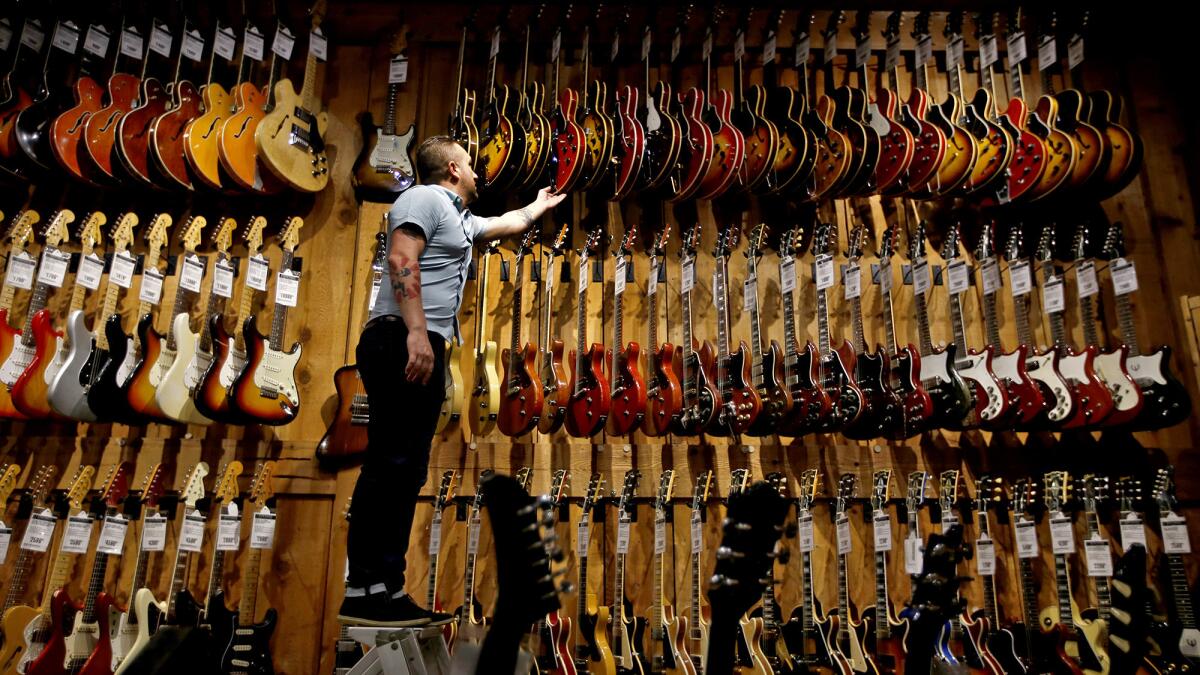
Guitar Center got its start in 1959 when former accordion and car salesman Wayne Mitchell bought the Organ Center, a small appliance and home-organ store in Hollywood. Mitchell later began carrying amplifiers after the Beatles’ landmark 1964 visit to the United States. He renamed his store the Guitar Center in 1971 to reflect the evolution of its stock.
It was only two years after Woodstock, and the electric guitar had become the symbol of rock ‘n’ roll in an era where fans were wowed by guitar gods such as Led Zeppelin’s Jimmy Page, Eric Clapton, Carlos Santana and the late Jimi Hendrix.
Guitar Center moved into a flagship store on Sunset Boulevard, expanded and in 1997, with 28 stores mostly on the West Coast, went public and started rapidly opening stores across the United States.
Ten years later, Boston-based private equity firm Bain Capital Partners took Guitar Center private in a highly leveraged $2.1-billion buyout.
The timing couldn’t have been worse: The 2007 deal saddled the retailer with heavy debt just as sales in the music industry stalled amid the financial crisis and Great Recession.
Los Angeles financial firm Ares Management took control of Guitar Center in 2014 in a $500-million debt-for-equity swap. There has been some talk of Ares taking Guitar Center public again.
“Guitar Center is a good business, and the Bain Capital guys paid a premium on it, expecting continued market growth,” said Brian Majeski, editor of Music Trades magazine. “The industry growth didn’t materialize.”
Bain Capital declined to comment. Ares did not respond to a request for comment.
A main drag has been the massive changes in retail as sales have migrated online. For example, Guitar Center has long generated income selling used instruments. But it now faces competition in that market from the likes of EBay and Reverb, an online musician marketplace, experts say.
Also, better technology has allowed musical instruments and equipment to be produced more cheaply, cutting into profits. A $4,000 electric keyboard is now $1,500. A sound system that once included two speakers and a substantial amount of equipment is now smaller, more powerful, and costs $2,000, rather than $5,000, Majeski said.
But Guitar Center retains some advantages. About 65% of the guitars, pianos and other items are subject to a manufacturer minimum advertised price, meaning Amazon cannot sell the product any cheaper than the music retailer. An additional 15% of its inventory is its own in-house brands, such as Livewire cables, Simmons electronic drum kits and Road Runner gig bags.
Guitar Center has also gone down market a bit. It used to be the place to buy a second guitar because it was too costly to start out there, but in the last decade, it has focused on following musicians from the start of what management calls their “journey.”
The retailer stocks used guitars for less than $50, ideal for someone just getting started, but also collector’s items, such as a used limited edition Fender 2004 Stevie Ray Vaughan Number One Stratocaster electric guitar, priced at $44,999.99. In between, there are models such as a classic Gibson Les Paul with an orange burst color scheme that costs $2,519.
“Guitar Center is still a well-managed business,” Majeski said. “If their debt burden was reduced, they’d be fine. No one would be having this conversation. It really stems back to — somebody paid too much for them.”
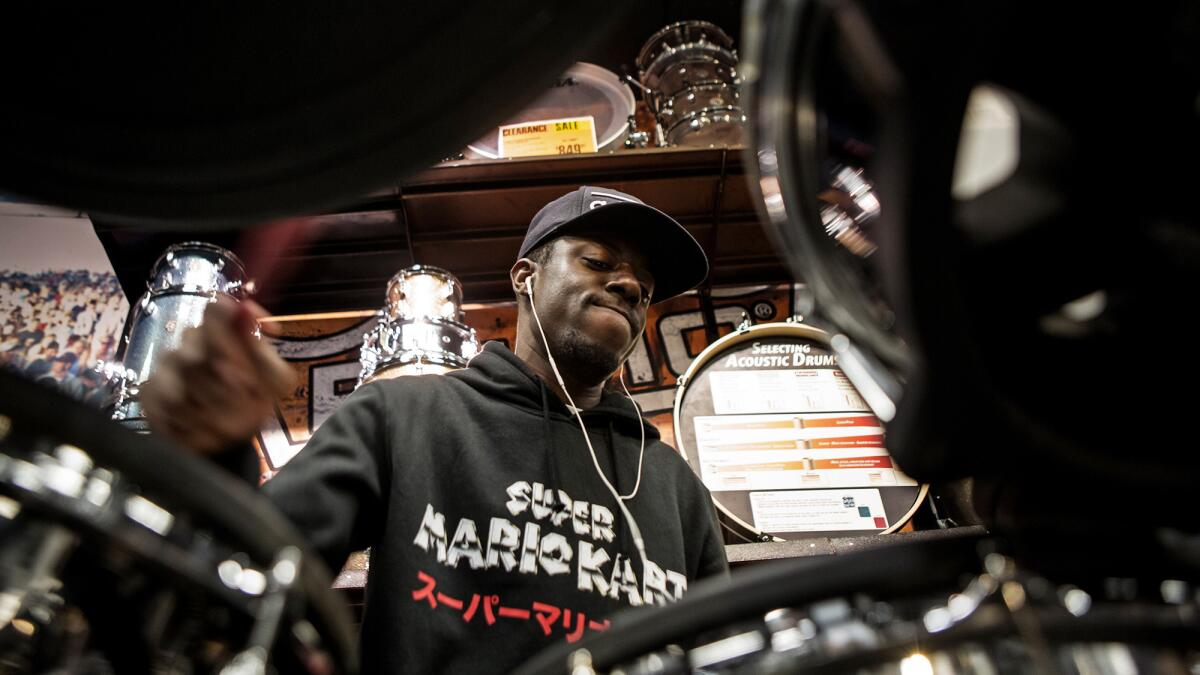
Guitar Center saw sales top $2 billion in 2016, but that was down 2.6% from the previous year, according to Music Trades, which follows industry trends. (Since the company is privately held it does not disclose its financials.) Its 11,000 employees, including nearly 2,100 in California, work in 450 locations nationwide, including 284 Guitar Center stores.
Despite the financial challenges, the retailer plans to open six more Guitar Centers and complete two store remodels, including a significant overhaul of its flagship and largest-volume store on Sunset Boulevard to be completed by the fall.
It also plans to add up to 30 Music & Arts stores, smaller outlets that sell and rent band and orchestra equipment. They also provide lessons on strings, horns and other instruments played in schools — some 1.5 million last year alone. The division, with more than 175 locations, has seen a recent return to profit growth, company executives say.
Meanwhile, at its existing namesake stores, it has tried to remain viable by spending $55 million to $80 million on upgrades and other improvements.
Some of that money went to building lesson spaces, which will be in every Guitar Center by the end of the year. Instructors offer lessons in guitar, piano, drums and vocals, among other things.
“In the day-to-day operations of the company, they’re being very aggressive and smart at what they’re doing,” said Frank Alkyer, publisher at Music Inc. magazine.
Inside its stores, Guitar Center has taken an approach similar to that of retailers such as Barnes & Noble, which has added coffee shops and chairs, and focused more attention on making customers want to stay.
Knowing that one of its strengths relative to online retailers is that musicians like to try out instruments before buying them, Guitar Center’s staff strategically places guitar picks and drumsticks for use.
“If you go into a lot of other instrument stores, they’ll have signs — ‘Please see a salesperson before you play’ or ‘Please don’t touch’ — we are the opposite,” said Martin, the CFO.
Pritcher, a guitar player turned pianist thanks to the time he spends in Guitar Center locations around L.A., is one of many regulars who appreciate that policy.
“It’s fantastic,” Pritcher said. “Otherwise, I wouldn’t be doing this.”
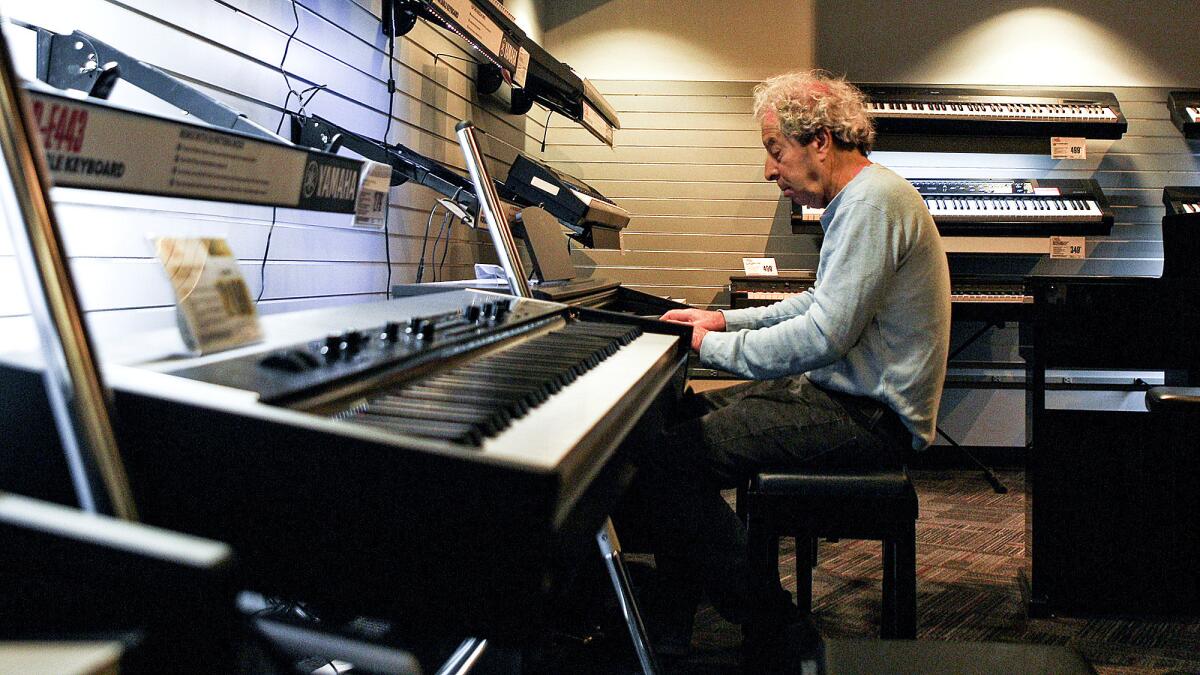
More to Read
Inside the business of entertainment
The Wide Shot brings you news, analysis and insights on everything from streaming wars to production — and what it all means for the future.
You may occasionally receive promotional content from the Los Angeles Times.
